Herbal Tea Market Research, 2032
The global herbal tea market was valued at $2.5 billion in 2022, and is projected to reach $4.3 billion by 2032, growing at a CAGR of 5.6% from 2023 to 2032. Herbal tea refers to beverages product made from the infusion or decoction of various herbs, spices, or other plant materials. The market consists of a wide range of herbal tea products, including different blends and varieties that utilize diverse botanical ingredients known for their aromatic, flavorful, and potentially health-promoting properties. Herbal teas can be consumed hot or cold and are often chosen for their unique flavors, potential health benefits, and the calming effects associated with specific herbal ingredients. These teas often attract consumers seeking natural and alternative health and wellness options.
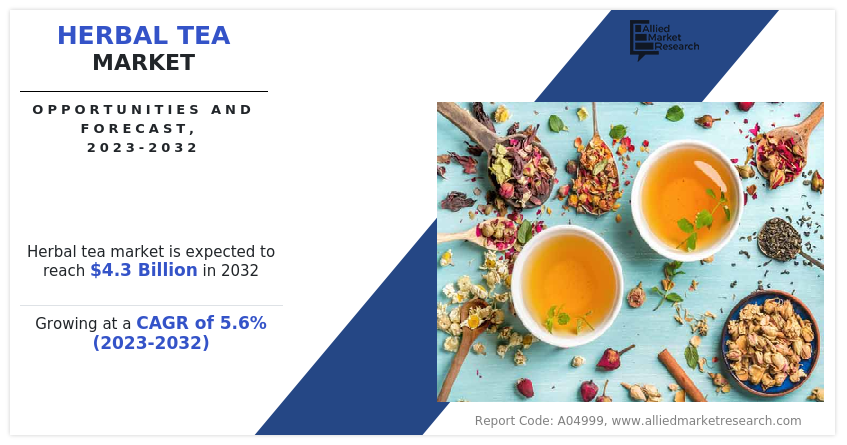
Market Dynamics
The herbal tea market has experienced rapid growth owing to the shift of consumers toward natural and organic tea beverages in recent times. Herbal teas, derived from dried herbs, flowers, fruits, and spices, offer a natural, plant-based beverage for health-conscious consumers. The absence of artificial flavors and preservatives caters to the preference for natural ingredients, attracting individuals seeking unprocessed beverage options. Many herbal teas, including those from popular brands such as Yogi Tea, Celestial Seasonings, Traditional Medicinals, Teeccino, Pukka Herbs, among others, are available in organic varieties. These teas feature ingredients cultivated without synthetic pesticides, herbicides, or genetically modified organisms (GMOs). The organic certification of herbal tea products serves well to consumers prioritizing products with minimal exposure to chemicals and environmentally sustainable practices.
Moreover, the natural and organic trend is closely linked to a demand for transparency in the food and beverage industry. Thus, herbal tea products that emphasize the traceability of ingredients, sourcing practices, and production methods are expected to gain the trust of consumers who value knowing the origins and manufacturing processes of their products. In addition, herbal teas, with minimal processing and transparent labeling, align with the clean label movement, appealing to those consumers who prioritize straightforward and honest product formulations. As a result, the utilization of various herbs, flower, and fruits in herbal teas contributes significantly to the growth of the herbal tea market share as more individuals prefer these natural beverages into their daily health routines.
However, the herbal tea market also faces certain barrier owing to high prices of herbal tea product as compared to other tea alternatives present in the market. Herbal tea products utilize high quality, natural, or ethically sourced ingredients, which may be expensive than conventionally cultivated or inferior substitutes. Moreover, certain herbal teas require specific levels of processing techniques, such as air-drying or hand-rolling. These methods demand manual labor and consumes more time, which thus increases the overall manufacturing expenses of herbal tea products. Some herbal teas may be sourced from specific regions or have limited availability, which makes them more exclusive and drives up the prices of herbal tea. For instance, Ginseng Oolong are sourced from specific regions in China or Korea known for high-quality ginseng. A rare and highly sought-after Darjeeling tea, known for its unique flavor profile, sourced exclusively from the Makaibari estate in the Darjeeling region of India. As a result, price-sensitive consumers in developing nations such as India, Indonesia, Nigeria, among others, may find high-priced herbal teas less affordable. This could lead to a decreased purchasing frequency or a shift to lower-priced alternatives, impacting the overall market demand for herbal tea.
The herbal tea market demand may face challenges in attracting price-sensitive consumers who are more inclined towards cost-effective beverage options available in the market. This sensitivity can result in a slowdown in the market growth of herbal tea products. Moreover, the high price of herbal tea is expected to limit the market to a specific demographic with higher disposable income. This segmentation can restrict the overall market reach and the potential for the broader adoption of herbal tea in the coming years.
There are significant opportunities in the herbal tea market, which is expected to drive the market growth of the market. The herbal tea market has experienced a surge in innovation owing to advances in technological and packaging aspects, driven by consumer demand for convenience, sustainability, and personalized wellness experiences. Cutting-edge methods, such as superficial fluid extraction (SCFE), microencapsulation, nanoemulsion technology, freeze-drying, and spray drying, are currently employed to safeguard the delicate tastes and scents of herbal teas. This ensures a consistently pleasant drinking experience for individuals. For instance, Stash lemon ginger immune support tea uses SCFE to extract flavor and aroma of ginger. Similarly, Pukka Herbs organic peppermint & spearmint tea uses spray drying to create a convenient and flavorful mint tea.
Environmentally friendly packaging materials, such as reused paper, degradable plastics, and plant-based fibers, are being extensively adopted to lessen the ecological effect of herbal tea packaging. Convenient and portable packaging formats, such as single-serve sachets, travel-friendly tins, and ready-to-drink bottles, are catering to the on-the-go lifestyles of consumers. Moreover, interactive features incorporated into packaging, such as QR codes, serve to provide customers with details regarding herbal teas, which consists of their health advantages, brewing instructions, and origins of sourcing. As people become more concerned about their health and develop a sense of curiosity regarding the products they consume, the accessibility of comprehensive data via QR codes is expected to act as a potent marketing strategy. As a result, this enhanced consumer interaction and transparency hold the potential to stimulate greater interest in natural herbal teas, consequently fostering the overall expansion of the herbal tea market size in the coming years.
Segmental Overview
The herbal tea market is analyzed on the basis of type, packaging, distribution channel, and region. By type, the market is divided into chamomile, peppermint, hibiscus, lemongrass, ginger, fruits, blends, and others. By packaging, the market is segmented into loose tea, paperboards, aluminum tins, and tea bags. Depending on distribution channel, it is classified into supermarket-hypermarket, specialty stores, convenience stores, online sales channel, and others. Region-wise, the market is analyzed across North America (the U.S., Canada, and Mexico), Europe (Germany, the UK, France, Italy, Spain, and the rest of Europe), Asia-Pacific (China, Japan, India, South Korea, Australia, Singapore, and the rest of Asia-Pacific), and LAMEA (Brazil, South Africa, Turkey, Saudi Arabia, Egypt, and the rest of LAMEA).
By Type
By type, the chamomile segment dominated the global herbal tea market in 2022 and is anticipated to maintain its dominance during the forecast period. The market for chamomile tea is driven by the significant active compounds present in chamomile, such as terpenoids alpha-bisabolol, and azulenes. These compounds exhibit antioxidant, antibacterial, and anti-inflammatory characteristics, which contributes to the popularity of this segment. Chamomile tea is often consumed for its potential health benefits, such as promoting relaxation, aiding in sleep, and helping with digestive issues. In addition, chamomile has a long history of traditional use in herbal medicine, particularly for its calming effects. Thus, this segment is to maintain dominance throughout the anticipated period.
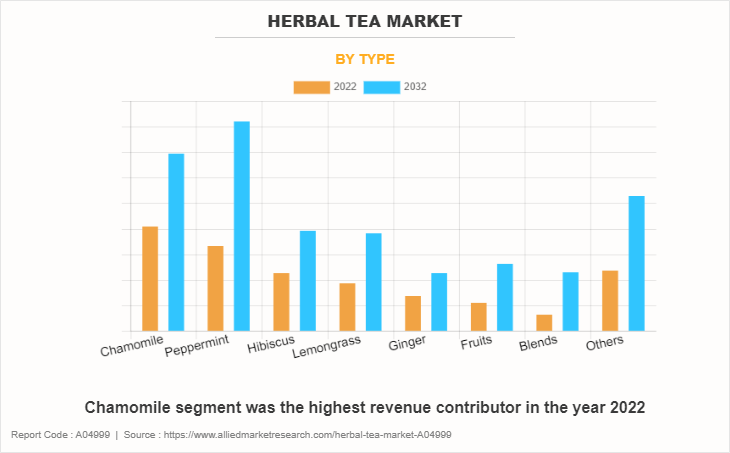
By Packaging
By packaging, the tea bags segment dominated the global herbal tea market in 2022. Busy and fast-paced lifestyle of consumers has propelled the demand for ready-to-use products such as tea bags. They are designed to provide a standardized flavor and strength, which ensures a consistent and reliable taste experience with each use. The tea bags offer a hygienic and mess-free alternative to another packaging of tea leaves available in the market. The contained nature of tea bags prevents tea leaves from floating freely in the cup and thus provides a cleaner drinking experience. Moreover, introduction of creative packaging designs and increase in focus on promotional campaigns as well as brand positioning have attracted a large consumer base. Overall, the convenience, time-saving benefits, consistent brewing results, and effective marketing efforts contribute to the widespread adoption of tea bags in the global herbal tea market.
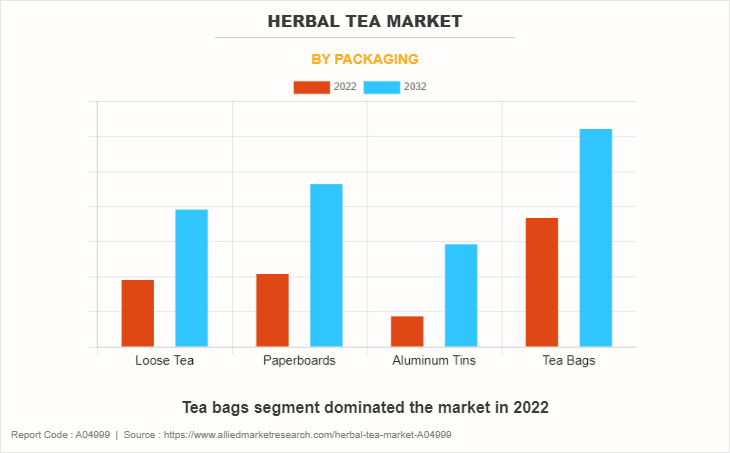
By Distribution Channel
By distribution channel, the supermarket-hypermarket segment dominated the global herbal tea market in 2022 and is anticipated to maintain its dominance during the forecast period. Hypermarket/supermarket is gaining popularity owing to the availability of broad range of consumer goods under a single roof, ample parking space, and convenient operation timings. Manufacturers work closely with retailers to secure optimal shelf space within hypermarkets and supermarkets. Placing herbal tea products prominently, such as at eye level or in high-traffic areas, increases visibility and the likelihood of customer engagement. Moreover, increase in urbanization, rise in working class population, and competitive pricing boosts the popularity of hypermarkets in the developed and the developing regions. These stores offer variety of brands in a particular product category, thus providing more options for the consumers to buy herbal tea products of their choice.
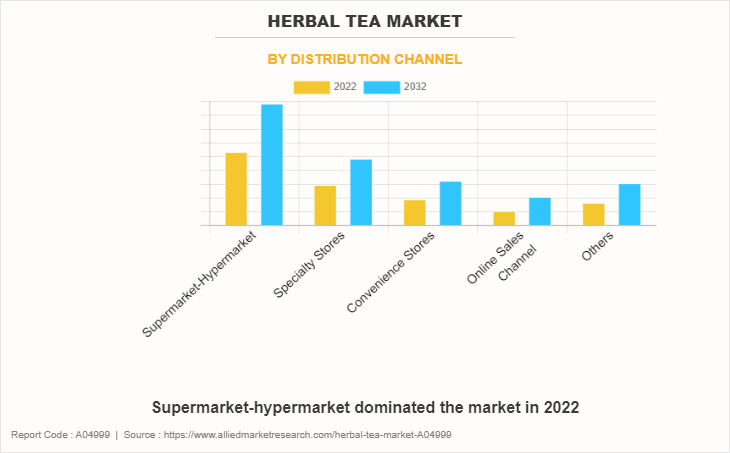
By Region
Region-wise, Asia-Pacific is predicted to dominate the market with the largest share during the herbal tea market forecast period. Herbal tea has held a significant place in traditional Chinese medicine and its therapeutic properties have been recognized and utilized for centuries in various herbal remedies. These herbal concoctions are highly regarded for their potential effectiveness in treating serious health concerns in this region. Moreover, herbal teas are grown in plenty in China, Japan, and India, thus, it may help the key players to cater to the requirements of consumers with less cost and effort, as people in this region are accustomed to the benefits of herbal tea. These factors are driving the herbal tea market growth in Asia-Pacific.
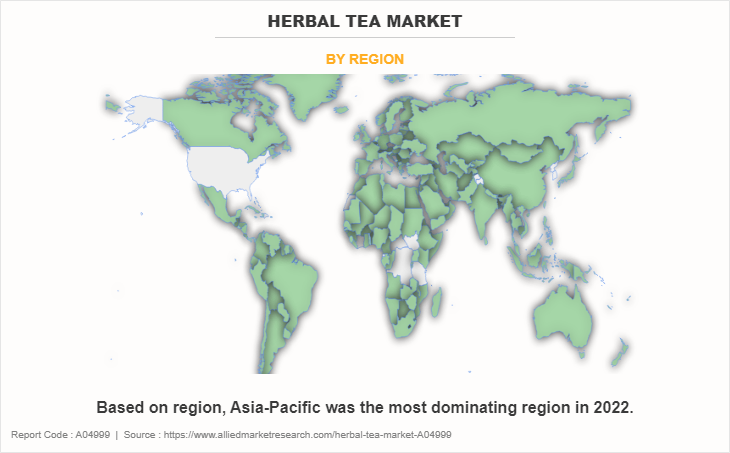
Competitive Landscape
The major key players include Tata Consumer Products Limited, The Hain Celestial Group, Inc., Dilmah Ceylon Tea Company PLC, Bigelow Tea, Tielka, Mountain Rose Herbs, Terra Teas Organic, Indigo Herbs Ltd, The Indian Chai, Organic India Pvt. Ltd.
Several well-known and up-and-coming brands are vying for market dominance in the fiercely competitive herbal tea industry. Smaller, niche firms have become more well-known for catering to particular consumer demands and tastes. Large companies, however, still control the majority of the market and frequently acquires creative startups to broaden their product lines.
Large multinational corporations with broad brand portfolios, global reach, and sizable marketing budgets, such as Unilever, Tata Consumer Products Limited, and The Hain Celestial Group, Inc., dominate the herbal tea market. They have the means to conduct considerable R&D and continual product development. With a focus on clean and sustainable products, niche brands such as Traditional Medicinals, David Wolfe, and The Republic of Tea, are gaining market dominance through targeted offers that address certain customer demands. For quick development, these brands work with influencers, social media, and digital marketing.
The direct-to-consumer (DTC) approach, made popular by companies such as Teeccino, Numi Organic Tea, among others, alters‐¯the market by avoiding conventional retail channels and enabling a direct relationship with customers. Private label brands created by merchants and e-commerce platforms are another aspect of the competitive market. While they provide more affordable options, they might have different recognition or range of products than‐¯well-known companies. An important competition component‐¯is innovation in formulations, ingredient sourcing, and sustainability policies. Brands that are able to change‐¯the tastes of their target market and align with their ethical and environmental values have an advantage over rivals operating in the herbal tea market.
Recent Developments in Herbal Tea Market
- In June 2023, Traditional Medicinal has launched new Canadian tea blend i.e., organic ginger lemon tea to expand the product portfolio of high-quality herbal teas.
- In May 2022, Organic India launched new variety of herbal tea such as Tulsi Detox Kahwa along with infusions such as Peppermint Refresh, Moringa hibiscus, and Simply Chamomile to cope up with shifting consumer preferences toward healthy alternatives post COVID-19 pandemic.
Key Benefits for Stakeholders
- This report provides a quantitative analysis of the market segments, current trends, estimations, and dynamics of the herbal tea market analysis from 2022 to 2032 to identify the prevailing herbal tea market opportunities.
- The market research is offered along with information related to key drivers, restraints, and opportunities.
- Porter's five forces analysis highlights the potency of buyers and suppliers to enable stakeholders make profit-oriented business decisions and strengthen their supplier-buyer network.
- In-depth analysis of the herbal tea market segmentation assists to determine the prevailing market opportunities.
- Major countries in each region are mapped according to their revenue contribution to the global market.
- Market player positioning facilitates benchmarking and provides a clear understanding of the present position of the market players.
- The report includes the analysis of the regional as well as global herbal tea market trends, key players, market segments, application areas, and market growth strategies.
Herbal Tea Market Report Highlights
| Aspects | Details |
| Market Size By 2032 | USD 4.3 billion |
| Growth Rate | CAGR of 5.6% |
| Forecast period | 2022 - 2032 |
| Report Pages | 279 |
| By Type |
|
| By Packaging |
|
| By Distribution Channel |
|
| By Region |
|
| Key Market Players | Tielka Pty Ltd., Mountain Rose Herbs, Dilmah Ceylon Tea Company PLC, Indigo Herbs Ltd., Bigelow Tea, The Indian Chai, Organic India Pvt. Ltd., Tata Consumer Products Limited, The Hain Celestial Group, Inc., Terra Teas Organic |
Analyst Review
The perspectives of the leading CXOs in the herbal tea industry are presented in this section. Based on the evaluations conducted on top-level executives, the global herbal tea market is poised for substantial expansion in the coming years. This growth is driven by various factors, which include increase in focus on health and wellness, surge in popularity of specialized tea varieties, benefits associated with herbal tea products, and surge in demand for herbal tea in emerging markets. In addition, the herbal tea market is being propelled by advancements in technology and ongoing product innovation, along with geographical expansion efforts, the utilization of e-commerce and online sales platforms, and the implementation of sustainability initiatives.
The executives have further emphasized that there is a significant opportunity for leading herbal tea market players to capitalize on these trends by diversifying their product portfolio, targeting untapped markets, and allocating resources to research and development, which will thus create innovative tea products that cater to evolving consumer preferences. Despite challenges such as intense price competition and complexities in the supply chain, the herbal tea market is projected to sustain its growth due to its broad consumer base in Asia-Pacific and its ability to adapt to changing market dynamics.
The global herbal tea market was valued at $2.5 billion in 2022, and is projected to reach $4.3 billion by 2032
The global Herbal Tea market is projected to grow at a compound annual growth rate of 5.6% from 2023 to 2032 $4.3 billion by 2032
The major key players include Tata Consumer Products Limited, The Hain Celestial Group, Inc., Dilmah Ceylon Tea Company PLC, Bigelow Tea, Tielka, Mountain Rose Herbs, Terra Teas Organic, Indigo Herbs Ltd, The Indian Chai, Organic India Pvt. Ltd.
Region-wise, Asia-Pacific is predicted to dominate the market with the largest share during the herbal tea market forecast period.
Increased shift toward natural and organic beverages, Expanding retail market
Loading Table Of Content...
Loading Research Methodology...



